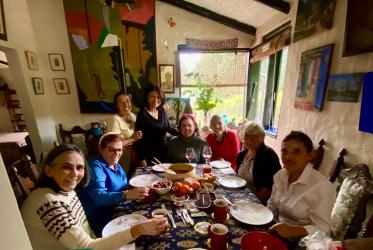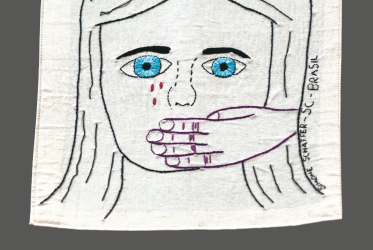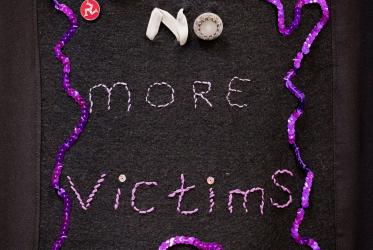10 Now he was teaching in one of the synagogues on the sabbath. 11 And just then there appeared a woman with a spirit that had crippled her for eighteen years. She was bent over and was quite unable to stand up straight. 12 When Jesus saw her, he called her over and said, “Woman, you are set free from your ailment.” 13 When he laid his hands on her, immediately she stood up straight and began praising God. 14 But the leader of the synagogue, indignant because Jesus had cured on the sabbath, kept saying to the crowd, “There are six days on which work ought to be done; come on those days and be cured, and not on the sabbath day.” 15 But the Lord answered him and said, “You hypocrites! Does not each of you on the sabbath untie his ox or his donkey from the manger, and lead it away to give it water? 16 And ought not this woman, a daughter of Abraham whom Satan bound for eighteen long years, be set free from this bondage on the sabbath day?” 17 When he said this, all his opponents were put to shame; and the entire crowd was rejoicing at all the wonderful things that he was doing.— Luke 13:10–17 (NRSV)
The Text in Its Context
Jesus refers only twice in the gospels to a person being a son or daughter of Abraham. Zacchaeus is called a “son of Abraham” (Luke 19:9), some exegetes would say, because the name “Zacchaeus” means “pure of heart.” Jesus is saying, yes, despite Zacchaeus’s job and supposed isolation, he indeed shall see God. Jesus is saying, Zacchaeus is a son of Abraham, he belongs.
Similarly, this bent woman is a Jew. She is called a “daughter of Abraham” (v. 16). Why? Because she is a Jew? This is obviously known, and everyone there seems to know her. In calling her by that title, Jesus links this woman to all those who received the promise God made to Abraham—that God would be their God.
At that time, a person with physical infirmity was usually set apart. They would be considered unclean, untouchable, like a leper, and not worthy of the full benefits the community had to offer. This was even more noticeable because the bent woman was a woman. Simply by calling this woman Abraham’s daughter, Jesus affirms her right to be a full member of the community.
Jesus shows incredible compassion throughout his life and had given many signs that he saw women as equal to men despite the cultural norms of his time. In his actions and relationships he reflected no sense of status dividing one person from another, nor was he anything other than inclusive in his behaviour towards people.
This incident is a reflection of all of these qualities so strongly reflected throughout the life of Jesus. Jesus looks at the crippled woman, and this would have meant bending down towards her. He becomes as she is, shows total empathy, identifies with her condition. She can only see feet and the dirt around her on the streets; she has been crippled for 18 years, half of her likely lifetime in those days. Most importantly, she cannot look people in the eye.
She does not request healing; she has accepted her lot. She is not called by name; she is a nobody—and Jesus makes her into a somebody. He enables her to have life and to have it to the full, both in a physical sense and as a daughter of Abraham. He sees she has the gift to see God; she is pure of heart. She now sees in the fullest of ways. She stands up, she sees, and she can be who she was born to become.
It was a sabbath. Here we have the dilemma of discerning how to balance the sabbath commandment and the commandment to love your neighbour as yourself. This was not, unlike with many of Jesus’s miracles on the sabbath, a condemnation by the Pharisees of Jesus for professing himself to be equal to God, that is, forgiving sins before healing someone physically. No, this was simply a condemnation of Jesus for breaking the law on the sabbath.
This was a natural response by Jesus to break open the rationale behind the law: Is the law to help or to hinder? Is the law to control others or to free them for greater love and joy? Jesus reflects, by his action, that the primary purpose of the law is to help the Jew to respond to God’s will with love and compassion, or to ignore it. The sabbath was made for a human person to rest and to give to God what is God’s. To deny that, is to deny his Father’s call to love, and in this situation, the call of God is to heal. Jesus looked at the woman, and he saw her deepest desire; he responded in love.
The Text in Our Context
Can we see with the eyes of Jesus when we walk the streets day by day? Do we see what he would see all around us?
The bent women and men are everywhere in front of our eyes. People bowed down by the burdens of life, rendered helpless and hopeless by the ills of society that disempower them and exclude them from citizenship and human rights. People bowed down by a neoliberal economy that has developed a yawning gap between the rich and the poor. A global society driven by greed, wealth, and deceit. A global organized crime that preys on those most vulnerable of people, who are so bowed down that they themselves cannot see a way out from such oppression.
How are we called to be “Jesus people” in our world in the face of such oppression? What is our deepest desire as we discern a response to the call of God today? Is the first step to do what Jesus did—to look and to see? Can we see the bent and broken today?
The bent woman might say, can we see her as a modern slave in a factory sweatshop? Are we blinded by the complex supply chains that hide these realities? Is she hidden from our sight in construction factories where traffickers ply their trade and control thousands of slaves bent down by the burden of debt, unbearable hours of unpaid work, and appalling conditions? Can we see her behind the counter in nail bars, car washes, hotel receptions, trafficked to feed the greed and demands of the rich for a quick fix or for cheap goods, cheap labour, cheap services?
Can we see Jesus in them?
Jesus spent hours in prayer and reflection. Is this a first step to really seeing—to stand back and really see and listen, read, and understand? Is Jesus desiring that we really see and commit ourselves, as he did, to doing his Father’s will? Is this a dynamic call to service by responding with love and compassion to the woman bent down in our world today?
What would this call be for us in real truth—can we see?
A True Story of the Bent Woman Today
A few years ago, I was invited by a street woman and her daughter to visit them where they lived in a little nook hidden from sight off a main street. The daughter was eleven when I first met her. The mother and daughter always stayed clean even though they lived on the street. No matter what I did, there was no way the mother was going to help the child go to school. She managed to beat the system. However, the girl, who was bright, was allowed to come to a church English class.
One day we noticed bruises on the girl’s arms. Our first step was to speak with the mother in a public place, as she was prone to manic attacks and could be violent. We were not able to bring the daughter to a safe meeting place with social workers. The girl declared the bruises were caused by debris falling on to her arms as she was rummaging for food. The mother was afraid the girl would be taken from her.
The church was providing food for both the mother and the daughter. We worked with a few caring institutions that focused on child protection, and together we decided to keep a careful watch. The bruises appeared again at a later date, and this time they were more severe.
One night we saw that the mother was taking her child to another part of town. She was forcing her child into sex work in a broken-down car, where the girl had to meet many clients each night. The child and mother were taken away from this place that very night, and after much conversation, the full story of physical and psychological abuse emerged, with an admission of guilt by the mother. Sadly, the girl needed to go into a safe environment, and her mother has not been able to live with her again. The mother understands this and is now housed elsewhere and is coping with life. The girl has come from this terrible, bent state of abuse and vulnerability, and after much therapy and love, is getting along well at university.
In the end, those who cared had to go outside the usual way of working and think outside the box in order to bring this girl out of her prison into freedom. They literally went seeking the truth, and they did see.
Sister Margaret Scharf, OP, invites us to seek the truth and see in her song “Can you see me?” written for the Australian Catholic Religious Against Trafficking in Humans (ACRATH) (https://acrath.org.au/videopage/can-you-see-me-7/).
Can you see me in the things that you purchase,
In a place where the prices there suit you so well?
Can you imagine this place where I’m working;
No food and no breaks, in a sweatshop that’s hell?
Can you see me?
Can you see me in the shadows and darkness,
Where my body is sold for minutes and hours?
Can you imagine the suffering in sex trade,
Where dreams are stolen and so is my power?
Can you see me?
We also can be inspired by the words of Saint Catherine of Siena: “Be who God meant you to be, and you will set the world on fire. … We have had enough exhortations to be silent! Cry out with a thousand tongues. … the world is rotten because of silence.”
Activities
• Join an anti-trafficking network near you and find out about modern-day slavery.
• Read the reports and books, and watch the videos available on the websites suggested under Resources to educate yourself on the phenomenon of human trafficking.
• Pray for an end to human trafficking. Pope Francis says not to go to bed each night without bringing to mind someone you know who is like this bent woman and excluded from society.
• Join a campaign against human trafficking.
• Check the production and supply chain of what you buy, even if it takes time, and only buy ethically.
• Buy only what you need and be prepared to pay more to buy ethically.
• Raise awareness in conversation about this massive injustice and cruelty in our society today.
• Consider whether you are being called to volunteer in a women’s shelter near you.
• Join the House of Prayer of Religious in Europe Networking Against Trafficking and Exploitation (RENATE) at the web link listed under Resources. Read the prayers and join in the actions with prayer.
Prayers
See the prayers to end human trafficking available from RENATE
Resources
Abarim Publications’ Biblical Dictionary: The Old Testament Hebrew word: זכך
Catherine of Siena Quotes. Goodreads. Accessed August 24, 2021. https://www.goodreads.com/author/quotes/5794057.Catherine_of_Siena.
Freedom Collaborative website. Accessed on July 20, 2021. https://freedomcollaborative.org/.
Mary Ward Loreto Foundation website. Accessed July 20, 2021. https://www.albaniahope.com/.
Religious in Europe Networking Against Trafficking and Exploitation website. Accessed July 20, 2021. https://www.renate-europe.net/.
Religious in Europe Networking Against Trafficking and Exploitation. “House of Prayer.” Accessed July 20, 2021. https://www.renate-europe.net/light-a-candle/.
Scharf, Margaret. “Can You See Me?”. Last modified on 13 October 2020. https://acrath.org.au/videopage/can-you-see-me-7/.
Stop The Traffik website. Accessed on July 20, 2021. https://www.stopthetraffik.org/.






